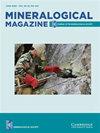Holubite, Ag3Pb6(Sb8Bi3)Σ11S24, from Kutná Hora, Czech Republic, a new member of the andorite branch of the lillianite homologous series
IF 1.4
3区 地球科学
Q2 MINERALOGY
引用次数: 0
Abstract
Abstract A new mineral species, holubite, ideally Ag3Pb6(Sb8Bi3)Σ11S24, has been found at Kutná Hora ore district, Czech Republic. The mineral is associated with other lillianite homologues (gustavite, terrywallaceite, vikingite and treasurite) most frequently as grain aggregates and replacement rims of earlier Ag–Pb–Bi minerals, growing together in aggregates up to 200 × 50 μm. It typically occurs in a close association with Ag,Bi-bearing galena and terrywallaceite. Holubite is opaque, steel-grey in colour and has a metallic lustre, the calculated density is 5.899 g/cm3. In reflected light holubite is greyish white and bireflectance and pleochroism are weak with grey tints. Anisotropy is weak to medium with grey to bluish-grey rotation tints. Internal reflections were not observed. Electron microprobe analyses yielded an empirical formula, based on 44 atoms per formula unit (apfu) of (Ag3.03Cu0.03)Σ3.06(Pb6.19Fe0.02Cd0.01)Σ6.22(Sb7.71Bi2.90)Σ10.61S24.12. Its unit-cell parameters are: a = 19.374(4), b = 13.201(3), c = 8.651(2) Å, β = 90.112(18)°, V = 2212.5(9) Å3, space group P21/n and Z = 2. Holubite is a new member of the andorite branch of the lillianite homologous series with N = 4. The structure of holubite contains two Pb sites with a trigonal prismatic coordination, eight distinct octahedral sites, of which one is a mixed (Bi,Ag) site and one is a mixed (Sb,Pb) site, and twelve anion sites. Holubite is defined as a lillianite homologue with the three following requirements: N = 4, L% [Ag+ + (Bi3+,Sb3+) ↔ 2 Pb2+ substitution] ≈ 70% and approximately one quarter to one third at.% of antimony is replaced by bismuth [Bi/(Bi+Sb) ≈ 0.26–34]. The new mineral has been approved by the Commission on New Minerals, Nomenclature and Classification of the International Mineralogical Association (IMA2022-112) and named after Milan Holub, a key Czech geologist and specialist in the Kutná Hora ore district.Holubite,Ag3Pb6(Sb8Bi3)∑11S24,来自捷克共和国KutnáHora,是绿柱石同源系列的一个新成员
摘要:在捷克kutn Hora矿区发现了一种新的矿物——空心长石,理想为Ag3Pb6(Sb8Bi3)Σ11S24。该矿物与其他榴辉石同源物(古氏辉石、陶粒辉石、维京石和宝石)伴生,最常见的是作为早期Ag-Pb-Bi矿物的颗粒团聚体和替代边缘生长在一起,团聚体可达200 × 50 μm。它通常与银、铋方铅矿和晶壁长石密切结合。空白石不透明,呈钢灰色,具有金属光泽,计算密度为5.899 g/cm3。在反射光下,白白石呈灰白色,双反射率和多色性较弱,呈灰色色调。各向异性是弱到中等的灰色到蓝灰色旋转色调。没有观察到内部反射。电子探针分析得到了44个原子/公式单位(apfu)的(Ag3.03Cu0.03)Σ3.06(Pb6.19Fe0.02Cd0.01)Σ6.22(Sb7.71Bi2.90)Σ10.61S24.12的经验公式。其单位胞参数为:a = 19.374(4), b = 13.201(3), c = 8.651(2) Å, β = 90.112(18)°,V = 2212.5(9) Å3,空间群P21/n, Z = 2。holuite是莲子岩同源系列中安长岩分支的新成员,N = 4。白长石的结构包括2个具有三角棱柱配位的Pb位,8个不同的八面体位,其中一个是混合(Bi,Ag)位,一个是混合(Sb,Pb)位,以及12个阴离子位。空白石定义为具有以下三个要求的橄榄石同源物:N = 4, L% [Ag+ + (Bi3+,Sb3+)↔2 Pb2+替代]≈70%和约四分之一至三分之一at。锑的%被铋取代[Bi/(Bi+Sb)≈0.26-34]。这种新矿物已得到国际矿物学协会新矿物、命名法和分类委员会(IMA2022-112)的批准,并以米兰·霍鲁伯(Milan Holub)的名字命名,他是捷克重要的地质学家和库特纳霍拉矿区的专家。
本文章由计算机程序翻译,如有差异,请以英文原文为准。
求助全文
约1分钟内获得全文
求助全文
来源期刊

Mineralogical Magazine
地学-矿物学
CiteScore
4.00
自引率
25.90%
发文量
104
审稿时长
6-12 weeks
期刊介绍:
Mineralogical Magazine is an international journal of mineral sciences which covers the fields of mineralogy, crystallography, geochemistry, petrology, environmental geology and economic geology. The journal has been published continuously since the founding of the Mineralogical Society of Great Britain and Ireland in 1876 and is a leading journal in its field.
 求助内容:
求助内容: 应助结果提醒方式:
应助结果提醒方式:


